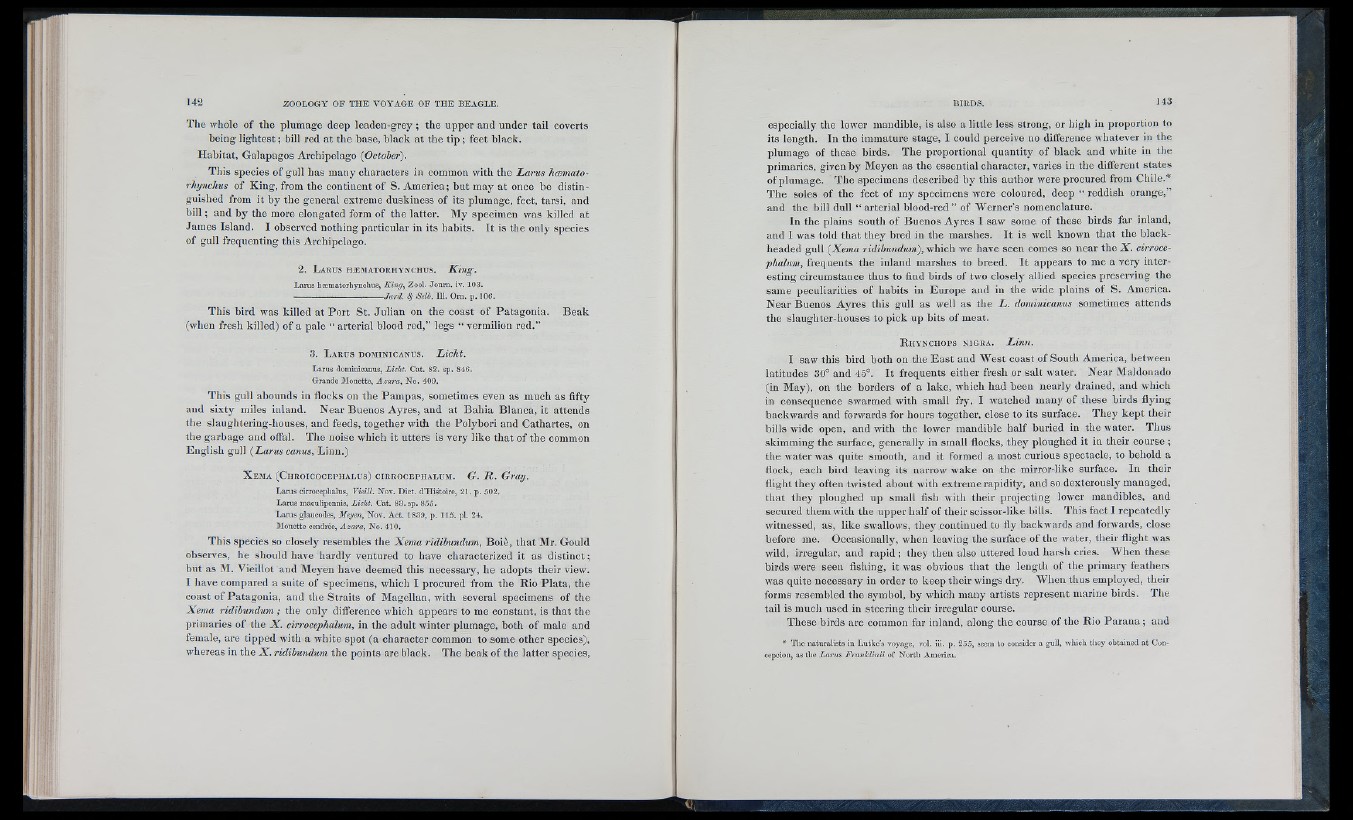
The whole of the plumage deep leaden-grey ; the upper and under tail coverts
being lightest ; bill red at the base, black at the tip ; feet black.
Habitat, Galapagos Archipelago (October).
This species of gull has many characters in common with the Larus hoetnato-
rhyncJius of King, from the continent of S. America; but may at once be distinguished
from it by the general extreme duskiness of its plumage, feet, tarsi, and
bill ; and by the more elongated form of the latter. My specimen was killed at
James Island. I observed nothing particular in its habits. It is the only species
of gull frequenting this Archipelago.
2 . L a r u s h æ m a t o r h y n c h u s . King.
Larus hæmatorhynchus, King, Zool. Joum. iv. 103.
--------------------------------- Jard. Sf Selb. IU. Orn. p. 106.
This bird was killed at Port St. Julian on the coast of Patagonia. Beak
(when fresh killed) of a pale “ arterial blood red,” legs “ vermilion red.”
3 . L a r u s d o m i n i c a n u s . Licht.
Larus dominicanus, Licht. Cat. 82. sp. 846.
Grande Mouette, Azara, No. 409.
This gull abounds in flocks on the Pampas, sometimes even as much as fifty
and sixty miles inland. Near Buenos Ayres, and at Bahia Blanca, it attends
the slaughtering-houses, and feeds, together with the Polybori and Cathartes, on
the garbage and offal. The noise which it utters is very like that of the common
English gull ({Larus canus, Linn.)
X e m a ( C h r o i c o c e p h a l u s ) c i r r o c e p h a l u m . G. R . Gray.
Larus cirrocephalus, Vieill. Nov. Diet. d’Histoire, 21. p. 502.
Larus maculipennis, Licht. Cat. 83. sp. 855.
Larus glaucodes, Meyen, Nov. Act. 1839, p. 115. pl. 24.
Mouette cendrée, Azara, No. 410.
This species so closely resembles the Xema ridibundum, Boiè, that Mr. Gould
observes, he should have hardly ventured to have characterized it as distinct;
but as M. Vieillot and Meyen have deemed this necessary, he adopts their view.
I have compared a suite of specimens, which I procured from the Rio Plata, the
coast of Patagonia, and the Straits of Magellan, with several specimens of the
Xema ridibutidum ; the only difference which appears to me constant, is that the
primaries of the X . cirrocephalum, in the adult winter plumage, both of male and
female, are tipped with a white spot (a character common to some other species),
whereas in the X . ridibundum the points are black. The beak of the latter species.
especially the lower mandible, is also a little less strong, or high in proportion to
its length. In the immature stage, I could perceive no diflerence whatever in the
plumage of these birds. The proportional quantity of black and wdiite in the
primaries, given by Meyen as the essential character, varies in the different states
of plumage. The specimens described by this author were procured from Chile.*
The soles of the feet of my specimens were coloured, deep “ reddish orange,”
and the bill dull “ arterial blood-red” of Werner’s nomenclature.
In the plains south of Buenos Ayres I saw some of these birds far inland,
and I was told that they bred in the marshes. It is well known that the blackheaded
gull (Xema ridibundum), which we have seen comes so near the X . cirrocephalum,
frequents the inland marshes to breed. It appears to me a very interesting
circumstance thus to find birds of two closely allied species preserving the
same peculiarities of habits in Europe and in the wide plains of S. America.
Near Buenos Ayres this gull as well as the L . dominicanus sometimes attends
the slaughter-houses to pick up bits of meat.
R h y n c h o p s n ig r a . Linn.
I saw this bird both on the East and West coast of South America, between
latitudes 30° and 45°. It frequents either fresh or salt water. Near Maldonado
(in May), on the borders of a lake, which had been nearly drained, and which
in consequence swarmed with small fry, I watched many of these birds flying
backwards and forwards for hours together, close to its surface. They kept their
bills wide open, and with the lower mandible half buried in the water. Thus
skimming the surface, generally in small flocks, they ploughed it in their course ;
the water was quite smooth, and it formed a most curious spectacle, to behold a
flock, each bird leaving its narrow wake on the mirror-like surface. In their
flight they often twisted about with extreme rapidity, and so dexterously managed,
that they ploughed up small fish with their projecting lower mandibles, and
secured tliem with the upper half of their scissor-like bills. This fact I repeatedly
witnessed, as, like swallows, they continued to fly backwards and forwards, close
before me. Occasionally, when leaving the surface of the water, their flight was
wild, irregular, and rapid ; they then also uttered loud harsh cries. When these
birds were seen fishing, it was obvious that the length of the primary feathers
was quite necessary in order to keep their wings dry. When thus employed, their
forms resembled the symbol, by which many artists represent marine birds. Tiie
tail is much used in steering their irregular course.
These birds are common far inland, along the course of the Rio Parana; and
* The naturalists in Lutke’s voyage, vol. iii. p. 255, seem to consider a gull, whicli they obtained a t Concepcion,
as the Larus Franklinii of North America.